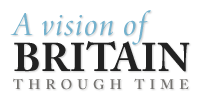In 1887, John Bartholomew's Gazetteer of the British Isles described Bradford like this:
Bradford.-- parl. and mun. bor., par., and township, N. div. West-Riding Yorkshire, 8 miles W. of Leeds. 34 SW. of York, and 191 from London by rail -- par., 32,929 ac., pop. 251,553; township, 1595 ac., pop. 68,372; bor., 10,775 ac., pop. 194,495 (the mun. bor. was considerably extended in 1882, and the parl. ...
bor. made conterminous with it in 1885, when it got an extra member); 10 Banks, 7 newspapers. Market-days, Monday and Thursday; has 5 public parks, and numerous handsome public buildings, -- St George's Hall (1851) accommodates 5000. Among its educational institutions are the Free Grammar School, endowed by Charles II.; and the Technical College (1882). B. is the chief seat in England of the mfr. of worsted and woollen stuffs, there being about 300 mills at work; it also carries on the mfr. of mixed cotton and silk goods, velvets, alpacas, &c. The Saltaire alpaca and mohair mills, erected by Sir Titus Salt, Bart., stand on the river Aire, 3 miles to the NW. There are numerous collieries and iron-works in the district. B. returns 3 members to Parliament -- 3 divisions, viz., West, Central, and East, 1 member for each division.
Bradford through time
Click here for graphs and data of how Bradford has changed over two centuries. For statistics for historical units named after Bradford go to Units and Statistics.
GB Historical GIS / University of Portsmouth, History of Bradford in West Riding | Map and description, A Vision of Britain through Time.
URL: https://www.visionofbritain.org.uk/place/1061
Date accessed: 07th May 2024
Not where you were looking for?
Click here for more detailed advice on finding places within A Vision of Britain through Time, and maybe some references to other places called "Bradford".
